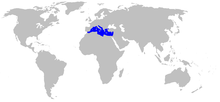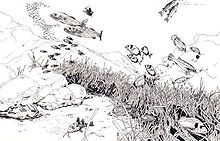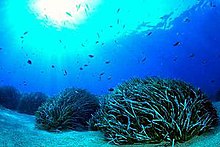Cygnis insignis (talk | contribs) →External links: {{Link FA|it}} |
m Some alterations, but not many |
||
| (One intermediate revision by one other user not shown) | |||
| Line 1: | Line 1: | ||
{{Taxobox |
{{Taxobox |
||
| image =Posidonia 2 Alberto Romeo.jpg |
| image =Posidonia 2 Alberto Romeo.jpg |
||
| image_name = ''Posidonia oceanica'' |
|||
| regnum = [[Plant]]ae |
| regnum = [[Plant]]ae |
||
| divisio = [[Flowering plant|Magnoliophyta]] |
| divisio = [[Flowering plant|Magnoliophyta]] |
||
| Line 9: | Line 8: | ||
| genus = ''[[Posidonia]]'' |
| genus = ''[[Posidonia]]'' |
||
| species ='''''P. oceanica''''' |
| species ='''''P. oceanica''''' |
||
| binomial= |
| binomial=''Posidonia oceanica'' |
||
| binomial_authority = ([[L.]]) [[Delile]] |
| binomial_authority = ([[L.]]) [[Delile]] |
||
| range_map =Posidonia_oceanica_range.PNG |
| range_map =Posidonia_oceanica_range.PNG |
||
| range_map_caption=Posidonia oceanica range |
| range_map_caption=''Posidonia oceanica'' range |
||
}} |
}} |
||
'''''Posidonia oceanica''''' is a species of [[seagrass]] that is endemic to the [[Mediterranean Sea]]. |
'''''Posidonia oceanica''''' is a species of [[seagrass]] that is [[endemism|endemic]] to the [[Mediterranean Sea]]. This marine plant forms large underwater meadows that are considered to be of high importance to the environmental conservation of the region. The fruit is free floating and known as the '''olive of the sea''' (''olive di mare''). Balls of decomposing detritus from the foliage of the plant, known as ''egagropili'', are found along nearby shore-lines. |
||
==Description== |
==Description== |
||
[[Image:P11007181.JPG|thumb|''Egagropili'' - Posidonia spheroids]] |
[[Image:P11007181.JPG|thumb|''Egagropili'' - ''Posidonia'' spheroids]] |
||
''P. oceanica'' is a flowering plant that occurs in dense meadows or along channels in sands of the Mediterranean. It is found at depths from 1 metre, and depending on the clarity of the water, up to 35 metres. Subsurface [[rhizome]]s and roots provide stability in the sands it occupies; erect rhizomes and leaves reduce the accumulation of silt. |
|||
The leaves are ribbon-like, appearing in tufts of 6 or 7, and up to 1.5 metre long. The average width is around 10 mm. They are bright green, perhaps becoming brown with age, have 13 to 17 parallel veins. The terminus of the leaf is rounded or absent |
The leaves are ribbon-like, appearing in tufts of 6 or 7, and up to 1.5 metre long. The average width is around 10 mm. They are bright green, perhaps becoming brown with age, and have 13 to 17 parallel veins. The terminus of the leaf is rounded or sometimes absent because of damage. They are arranged in groups with older leaves on the outside, longer and differing in form from the younger leaves they surround. |
||
The rhizome type stems are in two forms |
The rhizome type stems are found in two forms: one growing beneath the sand up to 0.15 m and the other rising above the sand to give its tufted appearnace. All stems are approximately 10 mm thick and upright in habit. This arrangement of the rhizomes eventually forms a [[matte]]; the surface contains the active parts of the plant, whereas the centre is a dense network of roots and decomposing stems. |
||
The flowering plant is known by the common name '''Neptune grass'''.<ref>{{cite web|url=http://www.divesitedirectory.co.uk/seagrass_meadows.html|title= ''Posidonia oceanis''}}</ref> |
The flowering plant is known by the common name '''Neptune grass'''.<ref>{{cite web|url=http://www.divesitedirectory.co.uk/seagrass_meadows.html|title= ''Posidonia oceanis''}}</ref> |
||
| Line 29: | Line 28: | ||
==Distribution== |
==Distribution== |
||
This species is found only in the Mediterranean Sea; occupying an area about 3% of the basin (corresponding to a surface area of about 38,000 km |
This species is found only in the Mediterranean Sea; occupying an area about 3% of the basin (corresponding to a surface area of about 38,000 km²), representing a kind of key marine coastal ecosystem. |
||
A sign of a nearby occurence of Posidonia is the presence of masses of decomposing leaves on beaches. |
A sign of a nearby occurence of ''Posidonia'' is the presence of masses of decomposing leaves on beaches. Such plant material has been used for composting, but this is currently prohibited by Italian laws that restrict the use of marine algae and plants for this purpose. |
||
[[Image:Ecosistema posidonia.JPG|thumb|Illustration of ''P. oceanica'' habitat]] |
[[Image:Ecosistema posidonia.JPG|thumb|Illustration of ''P. oceanica'' habitat]] |
||
==Taxonomy== |
==Taxonomy== |
||
The |
The genus epithet, ''Posidonia '', is named for the Greek god of the seas [[Poseidon]] and the species epithet, ''oceanica'', refers to the once wider distribution. |
||
[[Carl Linnaeus]] gave the first botanical description of this species in ''[[Systema Naturae]]'', although the genus was |
[[Carl Linnaeus]] gave the first botanical description of this species in ''[[Systema Naturae]]'', although the genus was then named ''Zostera''. |
||
The [[APG system]] (1998) and [[APG II system]] (2003) accept the genus as constituting the sole genus in the family [[Posidoniaceae]], which it places in the order [[Alismatales]], in the clade [[monocots]]. The |
The [[APG system]] (1998) and [[APG II system]] (2003) accept the genus as constituting the sole genus in the family [[Posidoniaceae]], which it places in the order [[Alismatales]], in the clade [[monocots]]. The Angiosperm Phylogeny Website concludes that the three families [[Cymodoceaceae]], Posidoniaceae and [[Ruppiaceae]] form a monophyletic group.<ref>[http://www.mobot.org/MOBOT/Research/APweb/orders/alismatalesweb.htm#Alismatales AP-Website]</ref> Earlier systems classified this genus in the family [[Potamogetonaceae]] or in the family Posidoniaceae but belonging to order [[Zosterales]]. |
||
==References== |
==References== |
||
Revision as of 23:40, 4 April 2008
| Posidonia oceanica | |
|---|---|

| |
| Scientific classification | |
| Kingdom: | |
| Division: | |
| Class: | |
| Order: | |
| Family: | |
| Genus: | |
| Species: | P. oceanica
|
| Binomial name | |
| Posidonia oceanica | |

| |
| Posidonia oceanica range | |
Posidonia oceanica is a species of seagrass that is endemic to the Mediterranean Sea. This marine plant forms large underwater meadows that are considered to be of high importance to the environmental conservation of the region. The fruit is free floating and known as the olive of the sea (olive di mare). Balls of decomposing detritus from the foliage of the plant, known as egagropili, are found along nearby shore-lines.
Description
P. oceanica is a flowering plant that occurs in dense meadows or along channels in sands of the Mediterranean. It is found at depths from 1 metre, and depending on the clarity of the water, up to 35 metres. Subsurface rhizomes and roots provide stability in the sands it occupies; erect rhizomes and leaves reduce the accumulation of silt.
The leaves are ribbon-like, appearing in tufts of 6 or 7, and up to 1.5 metre long. The average width is around 10 mm. They are bright green, perhaps becoming brown with age, and have 13 to 17 parallel veins. The terminus of the leaf is rounded or sometimes absent because of damage. They are arranged in groups with older leaves on the outside, longer and differing in form from the younger leaves they surround.
The rhizome type stems are found in two forms: one growing beneath the sand up to 0.15 m and the other rising above the sand to give its tufted appearnace. All stems are approximately 10 mm thick and upright in habit. This arrangement of the rhizomes eventually forms a matte; the surface contains the active parts of the plant, whereas the centre is a dense network of roots and decomposing stems.
The flowering plant is known by the common name Neptune grass.[1] In 2006 a huge clonal colony of Posidonia oceanica was discovered south of the island of Ibiza. At 8 km across and possibly up to 100,000 years of age, it may be one of the largest and oldest clonal colonies on Earth.[citation needed]
Distribution
This species is found only in the Mediterranean Sea; occupying an area about 3% of the basin (corresponding to a surface area of about 38,000 km²), representing a kind of key marine coastal ecosystem.
A sign of a nearby occurence of Posidonia is the presence of masses of decomposing leaves on beaches. Such plant material has been used for composting, but this is currently prohibited by Italian laws that restrict the use of marine algae and plants for this purpose.

Taxonomy
The genus epithet, Posidonia , is named for the Greek god of the seas Poseidon and the species epithet, oceanica, refers to the once wider distribution. Carl Linnaeus gave the first botanical description of this species in Systema Naturae, although the genus was then named Zostera. The APG system (1998) and APG II system (2003) accept the genus as constituting the sole genus in the family Posidoniaceae, which it places in the order Alismatales, in the clade monocots. The Angiosperm Phylogeny Website concludes that the three families Cymodoceaceae, Posidoniaceae and Ruppiaceae form a monophyletic group.[2] Earlier systems classified this genus in the family Potamogetonaceae or in the family Posidoniaceae but belonging to order Zosterales.
References

- Source: Italian wikipedia
External links
![]() Media related to Posidonia oceanica at Wikimedia Commons
Media related to Posidonia oceanica at Wikimedia Commons
![]() Data related to Posidonia oceanica at Wikispecies
Data related to Posidonia oceanica at Wikispecies
- Posidoniaceae in L. Watson and M. J. Dallwitz (1992 onwards) The families of flowering plants.
- National Center for Biotechnology Information
- Germplasm Resources Information Network: Posidonia
- Flora Europaea: Posidonia
- Ibiza's Monster Marine Plant. Ibiza Spotlight, 28 May 2006.